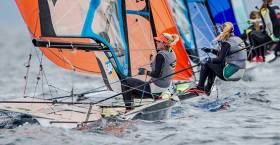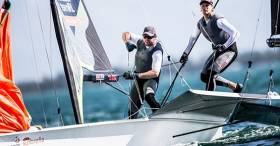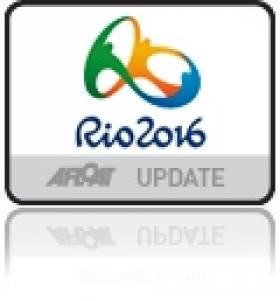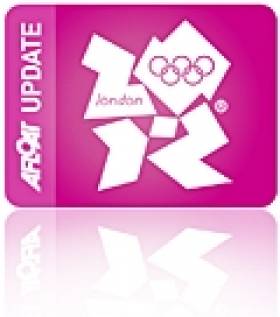Displaying items by tag: Matthew McGovern
Irish 49er is 24th at Hyeres Sailing World Cup
Light winds on the third day of the Sailing World Cup in Hyères did not favour Northern Ireland's Ryan Seaton and Matt McGovern yesterday. The Rio qualified pairing dropped seven places from 17th to 24 in the 40–boat fleet. The result is a disappointment for the Ballyholme Yacht Club pair who were seeking a return to the form that brought them silver medals in Hyeres two years ago and more recently gold in Palma at the start of this month. There was also a poor performance by the Irish 49erfx sailed by Andrea Brewster and Saskia Tidey. The Rio qualified duo from the Royal Irish Yacht Club are 23rd from 24.
Big breeze is expected to return to the venue this morning.
Sailors had a short wait for breeze in the morning but a 7-8 knot southerly veering to the west came through allowing a good number of races across the ten Olympic and two Paralympic fleets.
Looking further afield and the breeze that pushed sailors to their boundaries on the opening day is to return on Saturday leading through to Sunday's Medal Races which will be broadcast live on the World Sailing TV YouTube Channel.
After just eight races, Peter Burling and Blair Tuke of New Zealand have opened up a 37 point lead over the chasing pack.
Will and Sam Phillips (AUS) were in contention overnight but they slipped up with a 38 and a black flag. Meanwhile for Burling and Tuke it was business as usual. A first and a ninth gives them a monstrous lead which will take the pressure off in the coming days, not that there was any in the first place.
The Australian Phiilips sailors have been pulled back into a battle for the remaining medals. Jonas Warrer and Christian Peter Lubeck (DEN) are two points off them in third and five crews remain firmly in contention behind them.
Late off the water, at 19:15 local time, the 49erFX completed four races and Sweden's Lisa Ericson and Hanna Klinga (SWE) held on with a steady day of racing. Their results, a 2-1-3-(14), leave them on 20 points, 13 clear of Annemiek Bekkering and Annette Duetz (NED). Martine Grael and Kahena Kunze (BRA) are up to third.
Silver Fleet Wins Some Consolation for Northern Irish 49er Duo
There was consolation of sorts for Ryan Seaton and Matt McGovern with a string of race wins in the silver fleet of the 49er European Championships that ended in Barcelona yesterday. The Belfast duo had a scoreline of 1,1,1,3,4,3 but it was far from what they came to the Catalan capital for. The Ballyholme Yacht Club duo, who took gold at Princesa Sofia Regatta a fortnight ago, ended up 28th overall after some early costly mistakes including a costly start line infringement in the first race.
The campaign, that has achieved three top ten results at past world championships, carries Irish sailing hopes to Rio this summer. And as medal hopes, the team will want to analyse why, coming off such a great result in Palma, did they fare poorly this week?
The story of the 49er Euros is the Kiwi sensations, Peter Burling and Blair Tuke who wrapped up their 4th straight European Championship and 25th straight 49er regatta by a huge margin. The duo lead the regatta from start to finish, and never looked within the reach of any challengers.
The sailing world is already infatuated with these super performers. To dominate an Olympic class in this manner is rare, to do so while also winning Moth, A-Cat, and America’s Cup titles at the same time is truly novel. The pair are always around the boat park, part of the community, but such a cut above the rest that they are a constant source of discussion and amazement.
Locking in the Silver medal are Nathan Outteridge and Iain Jensen, on better form this regatta from start to finish than the recent past. The Aussie pair started the regatta well and tried to lock up with Burling and Tuke during races. They often started just to windward on the start line of the Kiwis to get a sense of just how large the speed gaps might be and how much work there is to reverse fortunes by August. There will be many doubters that it’s even possible to beat Burling and Tuke these days but in an Olympic environment, with fewer races, really unpredictable conditions, and distractions all over the Olympics are no sure bet despite how it may look.
Austria’s Nico Delle Karth and Niko Resch take a fair lead over the Brits and Spanish in to the medals race, which they must defend to become the top Europeans at the European Championship. It is a highly coveted title and one they will want to secure.
Irish 49erfx Campaign On Hold After Ankle Injury, Seaton & McGovern 15th on Day One of World Champs
The Irish 49erFX pairing still searching for Olympic qualification for this Summer's Olympics have withdrawn from this week's World Championships due to an ankle injury. Helmswoman Andrea Brewster sustained the knock in the lead up to last month's Miam World Cup event. Now, Brewster & crew Saskia Tidey will instead focus on getting ready for a qualification battle in Palma in March.
The Royal Irish Yacht Club pairing narrowly missed out on qualification in November last at the World Championships in Argentina. Now one European place remains available, which they can still compete for at the Princess Sofia regatta in late March in Palma, Mallorca but there is still cause for optimism in the Irish camp because on the basis of Brewster and Tidey's finishing position in Buenos aires they could well pick up the remaining African slot at the Palma World Cup in March as there does not appear to be an African nation with a 49erFx campaign.
Ryan Seaton & Matt McGovern are 15th from 56 after the first race of the 49er World Championships in Clearwater, Florida until Sunday. Having already qualified for the Olympic games, they will be using the regatta as preparation for the this summer's Olympics. Former World Cup silver medallists and Olympians at the London 2012 games, the Irish 49er skiff pairing are up against the world’s best sailors, including Australian Olympic champions Nathan Outteridge & Iain Jensen and the unbeaten New Zealand pairing of Peter Burling & Blair Tuke, who have not lost a competitive race in over 3 years on the global circuit.
In an ISA press release issued yesterday, Seaton commented on this year’s championships: "We feel the last few months of training and competition have been productive and this gives us another chance to prepare for the Olympics against the best sailors in the world. This is the last major championships before the World Cup series and we are looking to continue the work we have done on process, particularly around the start time. With two black flag disqualifications last week, we still have tweaking to do."
Providence Team IRL Performance Director, James O'Callaghan commented on the 49er's chances at the 2016 Worlds: “Only every four years does the Worlds get overshadowed. Even at this stage of the season the focus is on the Olympics this summer, so while a result would be a good marker to put down, it’s more important to improve skill sets in readiness for August. A World championships offers that opportunity in a high calibre fleet.”
Irish 49er & 49erfx Skiff Teams Make Gold Fleet in Buenos Aires
Both Irish mens and women's skiff teams made the Gold Fleet cut in the 49er and 49erfx World Championships in Buenos Aires yesterday – but only just in a day of drama at this notoriously difficult venue.
The qualifying series could not have been more challenging for the teams vying for Gold fleet inclusion, Olympic berths, and Olympic selection. Results are here.
Belfast's Team Seaton-McGovern, who are already qualified for Rio, took a fifth & 10th place to be 23rd from 66 on day three and Dun Laoghaire's Brewster and Tidey who are looking for qualification this week came fifth and are in 19th place from 44 after a last race retiral. Crucially, the girls are currently ranked fourth nation of those seeking the three Rio qualification places available this week. Singapore currently holds the third spot, six points ahead of the Irish duo. And in an important boost for Irish hopes neither Finland or Japan, both seeking a Rio slot, made the gold fleet cut yesterday thereby dashing their qualification chances.
Starting the day, the mens 49er teams vying for Olympic berths were huddled at the top of the 49er leaderboard, with 4 out of the top 6 teams looking to qualify their nation. By the end of racing today, 7 nations are looking for the 3 (and possibly up to 5 Olympic berths) with Argentina and Poland both having 2 teams in the hunt.
The real fleet depth in the 49er is on display here in Buenos Aires as only Championship favorites, Burling and Tuke (NZL), are sailing to expectation and at the top of the leaderboard.
Many of the rest of the presumed top 10 had to fight hard, right down to the final race just to make gold fleet with Fletcher/Sign (GBR), Outteridge/Jensen (AUS), Seaton/McGovern (IRL), and Warrer/Thomsen (DEN) all in danger of falling out of the Gold fleet split in the final race of the day. Of the bunch, the Brits and Outteridge proved clutch, with Fletcher/Sign winning the final race while Outteridge/Jensen pulled off two second places to close out the qualifying series.
#irish49er – Belfast's Ryan Seaton and Matt McGovern took to Twitter this afternoon to declare 'The comeback is on' after posting strong results for the sole Irish 49er team at the European Championships in Portugal. The Northern Ireland sailing duo, who have qualified Ireland for Rio, had a better day today counting a 2,3,9. Download the full results below. The three top ten placings put them in 18th overall from 79 starters. It's a significant improvement from 30th after yesterday's first three races and it puts them on course for gold fleet competition. It is, however, still some way off a top three overall, a finishing postition required if they want to improve their Irish Sports Council funding.
Awesome Leaping 49er At Porto Europeans
Conditions on day 3 of the 2015 49er & 49erFX European Championship were perfect on the Atlantic swell of Porto. Check out London Gold medalists Nathan Outteridge and Iain 'Goobs' Jensen jumping their 49er clear out of the water as they approach the windward mark (above).
"We were just practicing our foiling," joked Nathan Outteridge, who is also the helmsman for America's Cup Team Artemis in their foiling catamarans. With sunny skies, rolling seas, and great wind, he'll have to check his grin a bit to beat local leaders Jorge Lima and Jose Costa (POR) and Peter Burling and Blair Tuke (NZL) who have taken the last 16 49er regattas in a row, a record that stretches back to their Silver in London 2012.
49er Skiff Pair Pair Seaton & McGovern Lie 12th at World Championships
#irish49er – Ryan Seaton & Matt McGovern are 12th overall after Day 2 of the 49er World Championships. The Belfast lough pairing were placed 9th, 14th and 5th in the 97 boat fleet.
For full results and live tracking see http://49er.org/2013-world-championships/
Seaton and McGovern Take Their Place in 49er Medal Race
#PERTH2011 – A 'personal best' performance, eighth overall in the world championships and a chance to shine in tomorrow's medal race plus the all important ticket to the London Olympic regatta. Is it any wonder Belfast's 49er dinghy duo Ryan Seaton and Matthew McGovern are celebrating at the ISAF World Sailing Championships in Perth today?
The Irish pair started the day in 12th place and after the first two races where they finished 15th and 10th in the 67 boat fleet, they were in 10th position.
In sea breeze conditions they earned a sixth in the final race of the day to put them eighth overall and confirmed their place in tomorrow's medal race.
World number one pair Nathan Outteridge and Iain Jensen (AUS) are one step closer to winning the gold medal in the 49er skiff competition after finishing Saturday's three Gold fleet races with an impressive 17 point overall lead.
As the rest of the fleet battled for a position in Sunday's top 10 Medal Race, Outteridge and Jensen placed fifth, seventh and 10th to bring their points tally to 85.
World number two Nico Delle Karth and Nikolaus Resch (AUT) also had a great day on the water, making a stunning come-back from 22nd place to make it into the top 10 thanks to three wins in the last two days.
The Austrian pair had two firsts and an eighth on Saturday, putting them seventh overall with 123 points.
Despite holding first place throughout the week, John Pink and Rick Peacock (GBR) had a disappointing day, placing 24th in race 13 and 23rd in race 15.
This result means the British have dropped from the lead to third with 106 points, bumping Emil and Simon Toft Nielsen (DEN) into second place with 102 points.
Stand outs for Saturday's racing also included Yann Rocherieux and Mathieu Frei (FRA), who battled closely with their fellow French team, Noe Delpech and Julien d'Ortoli, to cross the line second in race 13 and first in race 14.
Outteridge and Jensen are guaranteed a medal in Sunday's final but must beat the Toft Nielsen brothers in order to secure the World Championship.
Medal Race Competitors: (subject to protest): 1. Outteridge and Jensen (AUS); 2. Toft Nielsen and Toft Nielsen (DEN); 3. Pink and Peacock (GBR); 4. Burling and Tuke (NZL); 5. Warrer and Hansen (DEN); 6. Storck and Moore (USA); 7. Delle Karth and Resch (AUT); 8. Seaton and McGovern (IRL); 9. Evans and Powys (GBR); 10. Noerregaard and Lang (DEN).
Sunday 18 December is the final day of racing in Perth. The only Irish sailors competing tomorrow are Seaton and McGovern.
































































